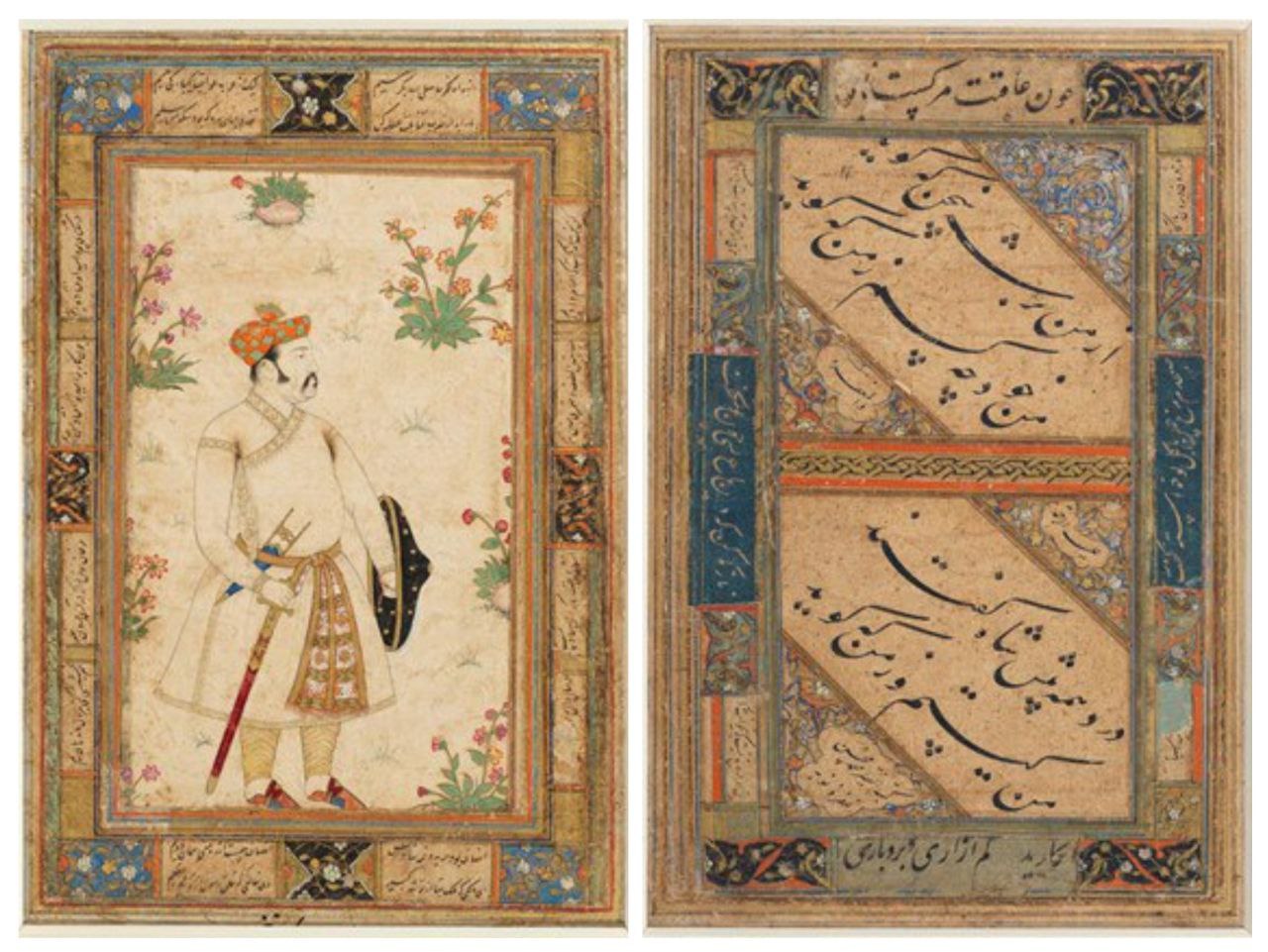The portrait of a Baburid prince is returning to Uzbekistan

The portrait of Prince Daniyal depicts him wearing a yellow-striped turban and a robe adorned with exquisite gold patterns, holding a talwar (Indian sword) in his right hand, with a katāra (dagger) tucked into the sash at his waist, and a round shield in his left hand, facing to the right. The background features floral sprigs. The painting is executed on paper using pigments and gold. This work dates approximately to the 1600s and belongs to either the Baburid or the Deccan school. It is mounted on a page from a Baburid album prepared in the 17th century, which features nasta‘liq calligraphy illuminated with pigments and gold, and bears an erroneous inscription at the bottom identifying the sitter as “Abdullah Khan Uzbek.” On the reverse side, there is a Persian quatrain written in colours and gold, signed by Muhammad Muhsin.
About Prince Daniyal
Prince Daniyal was the third son of the Baburid’s Emperor Akbar (1556–1605) and was highly valued by his father. He loved poetry and wrote verses in both Persian and Hindi. Daniyal was also a courageous military commander: in 1597, he was appointed governor of Allahabad, and in 1599, he was sent to the Deccan as heir apparent, leading several military campaigns. Sadly, he died in 1605 at the age of 32 due to alcoholism. Seven months after his death, his father Akbar also passed away.
About the portrait
There are differing opinions as to where this portrait was painted. Daniyal resided first in Allahabad and later in the Deccan. Prince Salim (later Emperor Jahangir) established a painting workshop in Allahabad around 1600–1604, during the period when Daniyal served as governor there. Baburid court artists were highly active at the time. The calligraphy on this album page is attributed to Muhammad Muhsin, which indicates that Prince Daniyal may have been a patron of such artists.
Several portraits of Daniyal are known. As Akbar’s son and the younger brother of the future emperor Jahangir, he was a figure of great interest to Baburid painters. A famous portrait painted by the artist Manohar (1600–1605) is preserved in the Kevorkian Album at the Metropolitan Museum of Art in New York. Other portraits are held in the Walters Art Museum in Baltimore (W.668, folio 28), the National Gallery of Canada (23557), the Bodleian Library at Oxford (Douce Or. a.1, fol. 29a), and the British Museum (1920,0917, O.13.34). In these paintings, Daniyal is also depicted facing to the right.
Baburid portraits of rulers and courtiers were typically painted in profile rather than full face, serving both to document court life and to celebrate art. Such works hold an important place in art history and were among the regular commissions of Baburid ateliers in the 17th century.
About the calligraphy
The delicate nasta‘liq script of Muhammad Muhsin, in which the quatrain is written, indicates that this album page was prepared for a high-ranking patron possibly Prince Daniyal himself.
Persian quatrain (on the reverse side):
از من بر شه سخن که گوید
من خود چه کسم سخن که گوید
درد همه پیش شاه گفتند
من کیستم و ز من که گوید
Translation:
Who is the one who spoke to the king about me?
Who am I, that anything could be said about me?
They have told all my sorrows to the king.
Who am I, that they should speak of me?
These lines are taken from the final chapter of the famous work Haft Awrang by the renowned poet Abdurahman Jami (d. 1492). Since the Baburid dynasty considered themselves descendants of the Timurids and held Jami in great reverence, the use of these lines is logically understandable.
About Muhammad Muhsin
The famous Ottoman historian Mustaqimzade Suleyman Sadeddin Efendi’s well-known work Tuhfat al-Khattatin contains information about Muhammad Muhsin. He was a student of the celebrated calligrapher Mahmud ibn Ishaq Shihabi (d. 1583), who served at the Shaybanid court. Muhammad Muhsin first served under Ubaydullah Khan in Bukhara, and later under Shah Husayn Shihabi in Balkh.
Muhammad Muhsin sought patronage at the Baburid court, especially from Prince Daniyal. This calligraphy page was prepared in that context, expressing the calligrapher’s gratitude, and was likely included in Prince Daniyal’s personal album.
This portrait is expected to be brought from the United Kingdom for the global exhibition to be held in connection with the opening ceremony of the Center of Islamic Civilization in Uzbekistan.
Durdona Rasulova
P/S: The article may be used provided that the official website of the Center is cited as the source.
Most read

Over 100 experts from more than 20 countries of the world are in Tashkent!

The Center for Islamic Civilization – a global platform leading towards enlightenment

The museum of the Center for Islamic Civilization in Uzbekistan has been further enriched: unique artifacts from different parts of the world have been presented as gifts











